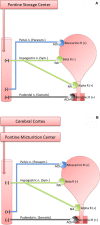Pathophysiology, Clinical Importance, and Management of Neurogenic Lower Urinary Tract Dysfunction Caused by Suprasacral Spinal Cord Injury
- PMID: 27527382
- PMCID: PMC5032886
- DOI: 10.1111/jvim.14557
Pathophysiology, Clinical Importance, and Management of Neurogenic Lower Urinary Tract Dysfunction Caused by Suprasacral Spinal Cord Injury
Abstract
Management of persistent lower urinary tract dysfunction resulting from severe thoracolumbar spinal cord injury can be challenging. Severe suprasacral spinal cord injury releases the spinal cord segmental micturition reflex from supraspinal modulation and increases nerve growth factor concentration in the bladder wall, lumbosacral spinal cord, and dorsal root ganglion, which subsequently activates hypermechanosensitive C-fiber bladder wall afferents. Hyperexcitability of bladder afferents and detrusor overactivity can cause urine leaking during the storage phase. During urine voiding, the loss of supraspinal control that normally coordinates detrusor contraction with sphincter relaxation can lead to spinal cord segmental reflex-mediated simultaneous detrusor and sphincter contractions or detrusor-sphincter dyssynergia, resulting in inefficient urine voiding and high residual volume. These disease-associated changes can impact on the quality of life and life expectancy of spinal-injured animals. Here, we discuss the pathophysiology and management considerations of lower urinary tract dysfunction as the result of severe, acute, suprasacral spinal cord injury. In addition, drawing from experimental, preclinical, and clinical medicine, we introduce some treatment options for neurogenic lower urinary tract dysfunction that are designed to: (1) prevent urine leakage arising because of detrusor overactivity during bladder filling, (2) preserve upper urinary tract integrity and function by reducing intravesical pressure and subsequent vesicoureteral reflux, and (3) prevent urinary tract and systemic complications by treating and preventing urinary tract infections.
Keywords: Cystometry; Dog; Spinal; Urinary; Urodynamics.
Copyright © 2016 The Authors. Journal of Veterinary Internal Medicine published by Wiley Periodicals, Inc. on behalf of the American College of Veterinary Internal Medicine.
Figures




References
-
- Bubenik LJ, Hosgood GL, Waldron DR, et al. Frequency of bacterial culture and susceptibility testing results for catheterized and noncatheterized dogs with urinary tract infection. J Am Vet Med Assoc 2007;231:893–899. - PubMed
-
- Olby NJ, MacKillop E, Cerda‐Gonzalez S, et al. Prevalence of urinary tract infection in dogs after surgery for thoracolumbar intervertebral disc extrusion. J Vet Intern Med 2010;24:1106–1111. - PubMed
-
- Granger N, Carwardine D. Acute spinal cord injury: Tetraplegia and paraplegia in small animals. Vet Clin Small Anim 2014;44:1131–1156. - PubMed
-
- Stiffler KS, McCrackin Stevenson MA, Sanchez S, et al. Prevalence and characterization of urinary tract infections in dogs with surgically treated type I thoracolumbar intervertebral disc extrusion. Vet Surg 2006;35:330–336. - PubMed
-
- Purinton PT, Oliver JE Jr, Bradley WE. Differences in routing of pelvic visceral afferent fibers in the dog and cat. Exp Neurol 1981;73:725–731. - PubMed
Publication types
MeSH terms
LinkOut - more resources
Full Text Sources
Other Literature Sources
Medical

